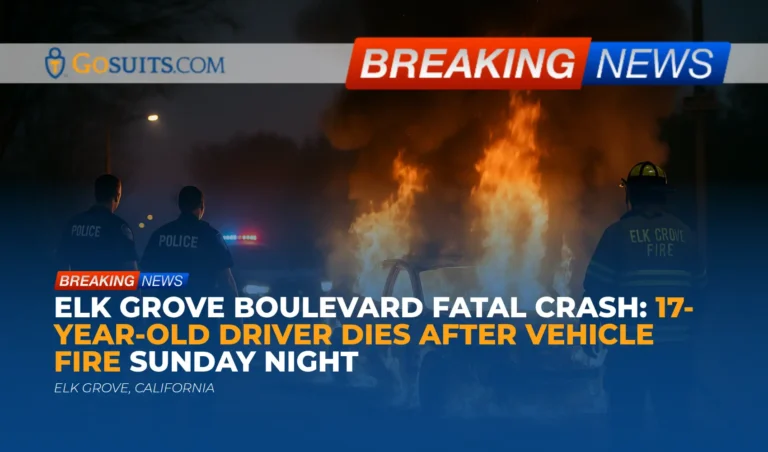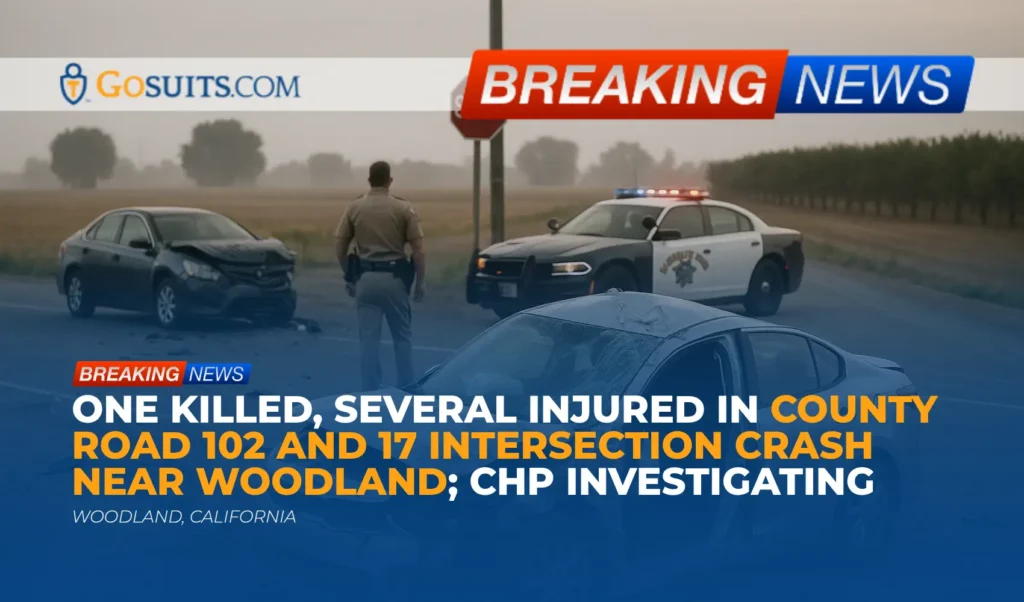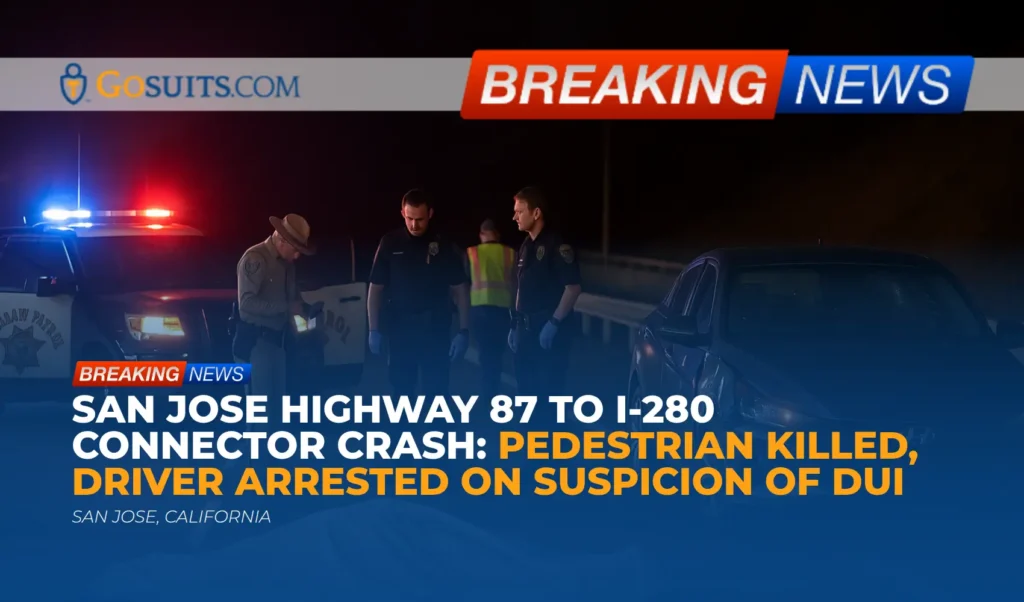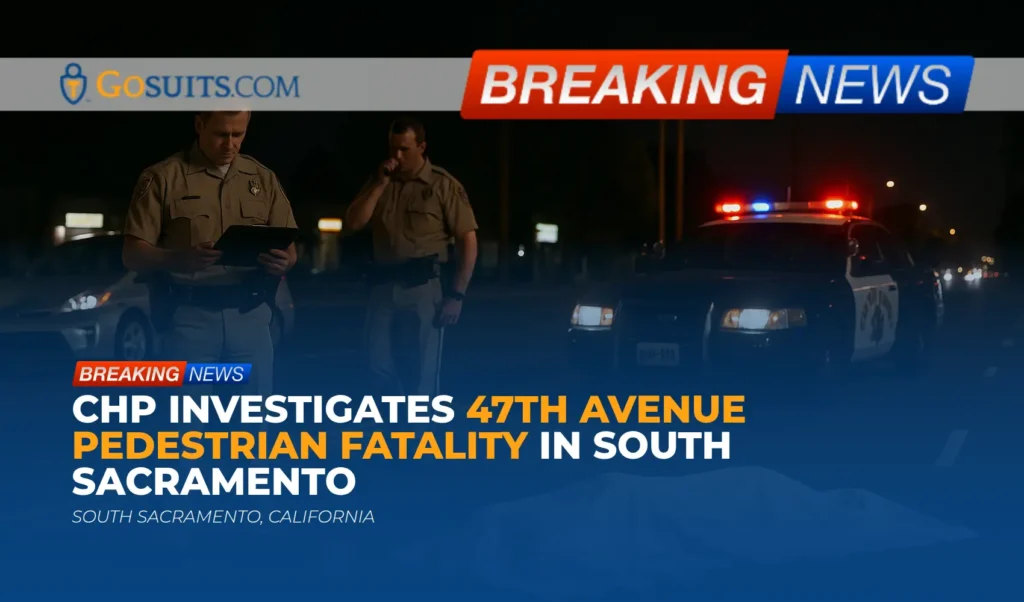- Overview of the Elk Grove Boulevard fatal crash
- What authorities have confirmed so far
- How crash and fire investigations typically proceed in California
- Where to obtain official records and information
- Legal context in California: wrongful death and related civil claims
- Potential civil liability considerations in a single-vehicle, post-crash fire
- Insurance issues and why early guidance matters
- Steps to preserve evidence and protect rights
- Public safety notes about teen drivers and vehicle fires
- Community grief and immediate support resources
- Commentary from Gosuits Elk Grove, California Personal Injury Attorney
- Action steps that should not wait
Overview of the Elk Grove Boulevard fatal crash
A tragic single-vehicle collision occurred Sunday night along Elk Grove Boulevard near Stonelake Drive in Elk Grove. According to initial reports, the vehicle caught fire after the crash, and the teenage driver—17 years old and the only person in the car—died at the scene. Authorities closed both directions of Elk Grove Boulevard between Waterfowl and Shorelake drives through the night to investigate and make the area safe for the public. At the time of reporting, the driver’s name had not been released.
For families, friends, and community members, the immediate aftermath of such a loss is overwhelming. This article explains what is publicly known, what steps authorities typically take in investigating crashes that involve fires, how families can request official records, and what civil legal avenues may exist under California law. It is written with care for those impacted and with an emphasis on facts and publicly available information.
What authorities have confirmed so far
Time and location
The crash happened a little after 8 p.m. on a Sunday night, along Elk Grove Boulevard near Stonelake Drive. The road closure extended between Waterfowl and Shorelake drives during the response and investigation.
Victim information
Police indicated the driver was a 17-year-old male and the sole occupant. His name has not been released pending family notification.
Vehicle fire
Authorities noted the vehicle caught fire after the crash. The specific cause of the crash and the cause of the post-crash fire have not been publicly determined.
Ongoing investigation
When a fatal collision occurs, the investigating agency typically documents the scene, gathers physical evidence, interviews witnesses, and may coordinate with specialized units or outside agencies for reconstruction and forensic analysis. Those steps often take days or weeks before a full report is finalized.
How crash and fire investigations typically proceed in California
When a collision results in a fatality, the investigating law enforcement agency will usually conduct a comprehensive inquiry to determine what happened. This can involve:
- Scene documentation using measurements, diagrams, and photographs, capturing roadway evidence such as skid marks, debris fields, vehicle rest position, and fire patterns.
- Vehicle inspection for mechanical condition, potential defects, damage patterns, restraint use, and post-crash fire indicators.
- Witness interviews and canvassing for camera footage from nearby businesses or residences.
- Forensic testing as needed, which can include toxicology, examination of vehicle components, or analysis by specialists in fire origin and cause.
- Report compilation and, if needed, supplemental reports once lab results or specialist evaluations are returned.
Post-crash fires can arise from multiple sources, including collision-related fuel system damage or electrical issues. The National Highway Traffic Safety Administration publishes consumer and safety information about vehicle fire risks and recalls, which may be relevant in some investigations. For general background on vehicle fire safety and defects, see NHTSA’s vehicle fire safety page. The U.S. Fire Administration also provides national statistics and educational materials regarding highway vehicle fires that help contextualize how often and why these events occur; see U.S. Fire Administration resources.
It is important to emphasize that, at this stage, there is no public confirmation of any specific cause here. Investigations are often methodical and take time, and families are typically updated through official channels.
Where to obtain official records and information
Police collision report
The investigating agency’s collision report is central to understanding the findings. In Elk Grove, the city’s police department investigates most city-street collisions. In some circumstances the California Highway Patrol (CHP) may investigate; if CHP handled a collision, involved parties can request a report using the CHP process. For general information on CHP collision reports and eligibility to request them, see the California Highway Patrol’s official website at chp.ca.gov.
For a city police investigation, involved parties, next-of-kin, or legal representatives can typically request the report directly from the department’s records unit. Each agency has its own forms and identification requirements, and reports are often withheld until the investigation is sufficiently complete. If unsure which agency is primary, a call to local non-emergency dispatch can help confirm the case number and the investigating unit.
Coroner and autopsy information
In California, county coroners investigate certain deaths, including those due to trauma. The California Government Code outlines coroner duties in death investigations, including determining cause and manner of death (Gov. Code § 27491).
Next-of-kin may request information from the county coroner’s office, including autopsy findings when applicable. Procedures vary by county regarding who can obtain reports and when they become available. The local coroner can advise on timelines, identification needed, and applicable fees.
Death certificates
Certified copies of death certificates are issued through county vital records offices and the California Department of Public Health (CDPH). Information on obtaining vital records is available on CDPH’s website: CDPH Vital Records. Funeral homes often assist families with the initial requests.
Traffic collision reporting to the California DMV
Separate from the police report, California law requires filing a report with the Department of Motor Vehicles in certain circumstances, typically when there is an injury, fatality, or property damage exceeding a statutory threshold. The DMV provides public guidance on accident reporting and financial responsibility requirements at dmv.ca.gov. Families or representatives often coordinate with insurers and counsel to ensure any required filings are handled correctly and on time.

Legal context in California: wrongful death and related civil claims
When a collision causes a fatality, California law provides civil avenues for certain family members or the estate to seek accountability and financial recovery from responsible parties. The right approach depends on what the investigation ultimately shows, which may include factors outside the driver’s control, such as dangerous roadway conditions, third-party negligence, or a vehicle defect.
Who may bring claims
California’s wrongful death statute allows certain relatives to bring a lawsuit for the losses they suffer due to a loved one’s death. Eligible persons are defined by statute, which commonly includes a surviving spouse, domestic partner, children, and sometimes others who were financially dependent. See California Code of Civil Procedure § 377.60.
Separate from wrongful death, a survival action allows the decedent’s estate to pursue claims the person could have brought if they had lived, for example, certain economic losses from the time of injury until death. See California Code of Civil Procedure § 377.30.
Time limits
California generally applies a two-year statute of limitations for wrongful death claims. See California Code of Civil Procedure § 335.1. However, shorter deadlines apply when claims involve public entities, as discussed below. Because these rules are strictly enforced, early review of potential claims helps families avoid missing critical deadlines.
Claims involving public entities
If a claim involves a public entity—for example, allegations of a dangerous condition of public property on a city-maintained road—California law requires a written administrative claim to be presented within a short timeframe, typically six months from the date of the incident. See California Government Code § 911.2. Substantive liability for dangerous conditions of public property is addressed in California Government Code § 835. Determining whether a public entity may be legally responsible requires careful evaluation of the roadway’s condition, signage, lighting, maintenance history, design standards, and whether the condition created a substantial risk when used with due care.
Potential civil liability considerations in a single-vehicle, post-crash fire
Although early reports indicate this was a single-vehicle crash, civil liability is still possible if factors outside the teen driver’s control contributed to the event or its severity. Without speculating about what happened in this case, the following categories often warrant careful review in fatal, post-crash fire scenarios:
- Roadway conditions and design. Questions include whether the road layout, curvature, sight lines, lighting, signage, or shoulder conditions contributed to loss of control or exacerbated risk. If a dangerous condition of public property is implicated, Government Code § 835 governs potential public entity liability, subject to immunities and defenses.
- Third-party negligence. Another road user may have cut off, forced evasive maneuvers, or otherwise contributed without remaining at the scene. Witness statements and camera footage can be crucial.
- Vehicle defects. Product liability concerns arise if the vehicle’s design or a component malfunction increased the risk of crash or post-crash fire. Investigations may consider fuel system integrity, battery systems in electrified vehicles, electrical harnesses, and whether recalls exist. For safety defect and recall information, NHTSA maintains public resources at nhtsa.gov/recalls.
- Maintenance and repairs. Recent work on fuel, electrical, or safety systems could become relevant if not performed to standard.
- Emergency response factors. While first responders work under demanding conditions, timelines and access can be analyzed in rare cases. Typically, however, liability in this area is limited by statutory protections.
Because findings depend on technical evidence, the sooner a thorough preservation effort begins, the more complete the picture investigators and analysts can form.
Insurance issues and why early guidance matters
Insurance coverage analysis in a fatal crash commonly involves multiple policies: the vehicle’s liability and potential coverages like medical payments; potential uninsured/underinsured motorist coverage on household policies; and policies for other involved parties or entities. California requires drivers to meet financial responsibility laws, including maintaining liability insurance, as explained by the California Department of Motor Vehicles at dmv.ca.gov.
In post-crash fire cases, comprehensive coverage may also be implicated for property loss, while liability policies are evaluated for bodily injury damages. If a defect or public entity is involved, separate policies or self-insured programs could come into play. Navigating these issues is complex because insurers ask for recorded statements, authorizations, and documents that can affect the claim.
Before communicating substantively with any insurance adjuster, it is prudent to seek a free consultation with a qualified attorney. What is said to an insurer may be used to limit or deny a claim later. Written communications, including proof-of-loss submissions, should be carefully reviewed, especially where multiple coverages or entities are involved.
Steps to preserve evidence and protect rights
While every situation is unique, the following steps are often important to a thorough civil evaluation after a fatal collision involving a fire:
- Identify the investigating agency and case number. Confirm whether the investigation is being handled by Elk Grove Police or CHP. Keep documentation of any notifications received.
- Request official records when available. Obtain the police collision report from the investigating agency once it is releasable, and request any supplemental or reconstruction reports. If the CHP is involved, information is available through chp.ca.gov.
- Contact the county coroner’s office. Ask about the process and timeline for receiving autopsy findings and related documents. Coroner duties are established by California law (Gov. Code § 27491), and local offices can explain next-of-kin access.
- Secure vehicle and component access. If the vehicle is towed or stored, preserve it for inspection before disposal. Fire-related evidence can be time-sensitive. Written “spoliation” notices may be appropriate to storage yards or insurers to prevent destruction.
- Locate potential video and witnesses. Promptly canvass the area for private security cameras or dashcams. Many systems overwrite footage within days.
- Document the scene and roadway. Photographs or measurements taken soon after the event can capture conditions that change quickly due to repairs, weather, or traffic.
- Evaluate public entity notice requirements. If roadway issues are suspected, be mindful of the six-month claim presentation deadline under Gov. Code § 911.2.
- Consider DMV reporting obligations. Review the California DMV’s guidance on accident reporting and financial responsibility requirements at dmv.ca.gov.
Public safety notes about teen drivers and vehicle fires
Any discussion of a teen’s death must remain respectful and avoid speculation. It can, however, be helpful to understand general safety context to inform community prevention efforts.
Teen driver risk factors
National public health research shows teens face elevated crash risk due to inexperience and the complex demands of driving. The U.S. Centers for Disease Control and Prevention provides education on teen driving risks and proven prevention strategies such as nighttime driving limits, graduated driver licensing components, and seat belt use. See the CDC’s overview at cdc.gov. These resources are intended for general safety awareness and do not imply any cause in this specific incident.
Vehicle fire awareness
Post-crash fires remain a serious hazard. NHTSA maintains information about vehicle fire safety, recalls, and reporting safety defects to assist the public and investigators in identifying and addressing potential hazards. For general information, visit NHTSA Vehicle Fire Safety. The U.S. Fire Administration also publishes educational materials that contextualize highway vehicle fire risks nationwide at usfa.fema.gov.

Community grief and immediate support resources
Grief after a sudden loss is profoundly personal and can feel isolating. There are public resources that provide immediate, confidential support at no cost. The nationwide 988 Suicide and Crisis Lifeline can be reached by dialing or texting 988. The program’s official federal information is available through the Substance Abuse and Mental Health Services Administration at samhsa.gov/find-help/988. Even if someone is not in immediate crisis, compassionate listeners can help connect people with local resources.
For official documents and practical matters, the CDPH provides guidance on obtaining death certificates and other vital records, which many institutions require for administrative tasks. See CDPH Vital Records.
Commentary from Gosuits Elk Grove, California Personal Injury Attorney
Our hearts are with the family and loved ones grieving this devastating loss. A life lost so young affects an entire community. This article is provided for educational and general information purposes during a difficult time.
From a civil injury perspective, fatal crashes that involve a post-collision fire call for careful, fact-driven analysis. Even when a crash appears to be “single-vehicle,” it is important not to assume the cause. A thorough review often considers whether roadway conditions, visibility, signage, vehicle systems, or the actions of other drivers played a role. If a contributing factor outside the driver’s control is identified, California law provides pathways for families to seek accountability through wrongful death and, where appropriate, survival actions under CCP § 377.60 and CCP § 377.30. When public property conditions may be involved, claim presentation deadlines such as those in Gov. Code § 911.2 require prompt attention.
Insurance companies and large organizations have extensive experience managing claims. They often move quickly to gather statements and documents that shape the outcome. Many people are not aware that what they say to an adjuster can be used to minimize or challenge their claims. Policies, exclusions, and limits can also be confusing, especially where multiple coverages or entities are involved. Early guidance helps level the playing field, ensures evidence is preserved, and prevents avoidable missteps.
Obtaining a free consultation is an important step because it allows families to understand their options, timelines, and the practical steps involved without financial pressure. A consultation can also coordinate the collection of official records, vehicle inspection, and insurance communications so that families can focus on honoring their loved one while important deadlines and evidence are managed appropriately.
Action steps that should not wait
The immediate period after a fatal collision is emotionally overwhelming, yet certain practical steps are time-sensitive and can make a meaningful difference in the clarity of the investigation and any subsequent civil case evaluation. The following actions are typically most urgent:
- Confirm the investigating agency and obtain the case number. This makes later requests for official reports and updates more efficient.
- Preserve the vehicle and key components. Fire-related evidence can degrade or be disposed of quickly. Storage yards, insurers, and any custodians should be notified in writing to preserve the vehicle for inspection.
- Secure nearby video evidence. Traffic cameras, commercial security systems, and private doorbell cameras often overwrite footage in days. Early canvassing maximizes the chance of preservation.
- Note any roadway or environmental conditions. Lighting, signage visibility, construction zones, and debris can change rapidly after a crash. Prompt documentation helps ensure accurate evaluation of potential public property issues.
- Coordinate with the coroner’s office. Ask about timelines for autopsy findings and what documentation next-of-kin will receive. Understanding the process can inform other time-sensitive steps.
- Track deadlines. California’s general wrongful death timeline is two years (CCP § 335.1), but if a public entity may be involved, the claim presentation deadline is often six months (Gov. Code § 911.2). Missing a deadline can limit civil options.
- Review DMV obligations. California’s financial responsibility and accident reporting rules are explained by the DMV at dmv.ca.gov. Ensuring the correct forms are filed avoids administrative complications.
- Speak with an attorney before dealing with insurers. A free consultation can explain rights and risks. Statements to insurance adjusters can be used to limit claims later, so guidance beforehand is beneficial.
Taking these steps promptly helps secure critical evidence, clarifies what happened, and protects the ability to pursue civil remedies if the facts support them. While nothing can undo the loss, informed and timely action can honor a loved one by ensuring that answers are pursued with care and that the legal process, if appropriate, proceeds on a complete and accurate record.






